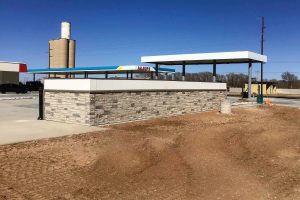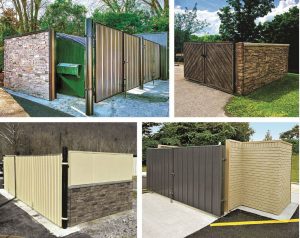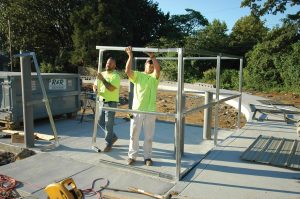— By Rodney Jarboe —
How modular trash enclosures keep dumpsters out of sight, but not out of mind.
In the not-so-distant past, almost nobody was paying attention to the design or materials used for dumpster enclosure construction. A dumpster is a dumpster, right? Cover it up! These days dumpster enclosures are getting more attention due to three key factors.
Key Factors Affecting Trash Enclosures
First, the enclosures themselves are taking up a larger footprint than ever before due to the new recycling bin requirements in addition to the standard trash dumpsters. The size of most enclosures has evolved from a single dumpster enclosure sized 10 foot by 10 foot to a double dumpster enclosure ranging in size — anywhere from 10 foot by 20 foot to 12 foot by 24 foot. In some cases, even more space is being added for various recycling containers, pallets, ladders, maintenance tools and other miscellaneous items.

Rodney Jarboe, Replications Unlimited
The second factor is the recent surge of new construction and remodel design upgrades for the exterior façade of fast food restaurants, convenience stores and retail stores. As these three different markets are all redesigning their next generation of building facades, designers, architects and store owners recognize that these larger-footprint dumpsters can’t just hide in the corner of the lot anymore. Dumpster enclosures are now a more prominent element on the property and are part of the upgrade process.
Finally, dumpster enclosure designs are being policed by townships, cities and high-end residential communities, setting new standards on the physical appearance and allowable materials for building the enclosures. Stores in the permitting process for either a remodel or new construction project are seeing the dumpster is now an integral part of the review and approval process — and in nearly all instances, this is the point at which the city is requiring the dumpster to meet new standards in appearance.
Types of Enclosure Categories
We are in a materials transition period for the enclosure wall portion of the dumpster enclosure design. There are various categories of enclosure wall systems with advantages, disadvantages and relative costs. Traditional chain-link fences, wood and even CMU concrete block are in the phase-out period as they lack curb appeal and can be high-maintenance. Due to new renovation trends and code approval requirements, real brick, brick veneer and cultured stone are now taking over as preferred materials. This shift to masonry-like materials is causing some concerns and backlogs in the industry. Due to the high cost of installing masonry and the recent shortage of masons, developers and owners are searching for alternative materials for these larger enclosures.
 Modular dumpster enclosures are a rapidly growing category of pre-engineered kits. Designed in both standard and custom sizes and bolted onto a standard dumpster pad, installation can be done by fence contractors or the on-site contractors already working on the main structure.
Modular dumpster enclosures are a rapidly growing category of pre-engineered kits. Designed in both standard and custom sizes and bolted onto a standard dumpster pad, installation can be done by fence contractors or the on-site contractors already working on the main structure.
Modular enclosures are available in two sub-categories. Category 1 is an ‘architectural panel’ system where enclosure walls are individual panels with a visible but decorative metal framing system. The finishes and textures within this framing can vary from various metal colors and finishes to inserting synthetic wood planks or other patterns. While this system provides a high-quality appearance, the framing appears in ‘cookie-cutter type sections’ that do not produce a seamless impression — and it doesn’t blend in with the main store’s exterior design.
 Innovation means constant evolution, and with the advancing tide for attractive, competitive, modular dumpster systems on the horizon, a new system was born. ‘Choice enclosures’ duplicate the more expensive masonry stone and brick façade at a fraction of the combined cost of materials and labor. Stone and brick panels connect to form a continuous and seamless appearance that can be color-matched to the building. The tubular steel framing is unique in that it has an on-site adjustable interlocking metal tube system and is not visible from the project’s exterior. The system includes a layer of metal siding between the frame system and textured panels providing a clean interior appearance with support to the exterior brick or stone panels. The choice enclosure system has more versatility than any standard system on the market today. The brick and stone panels are easily mixed and matched with wood, stucco and metal panels to provide full customization.
Innovation means constant evolution, and with the advancing tide for attractive, competitive, modular dumpster systems on the horizon, a new system was born. ‘Choice enclosures’ duplicate the more expensive masonry stone and brick façade at a fraction of the combined cost of materials and labor. Stone and brick panels connect to form a continuous and seamless appearance that can be color-matched to the building. The tubular steel framing is unique in that it has an on-site adjustable interlocking metal tube system and is not visible from the project’s exterior. The system includes a layer of metal siding between the frame system and textured panels providing a clean interior appearance with support to the exterior brick or stone panels. The choice enclosure system has more versatility than any standard system on the market today. The brick and stone panels are easily mixed and matched with wood, stucco and metal panels to provide full customization.
 A spin-off of the brick and stone modular enclosure system is a simple decorative ‘metal siding’ system. Unlike the ‘architectural metal panel’ systems with visible framing on the exterior, the metal siding system utilizes the interior support framing, allowing for a seamless and continuous appearance on the exterior . The key to this system is the wide range of metal siding colors and metal profile options at a low cost.
A spin-off of the brick and stone modular enclosure system is a simple decorative ‘metal siding’ system. Unlike the ‘architectural metal panel’ systems with visible framing on the exterior, the metal siding system utilizes the interior support framing, allowing for a seamless and continuous appearance on the exterior . The key to this system is the wide range of metal siding colors and metal profile options at a low cost.
Let’s Talk Logistics
There is a significant amount of activity in the convenience store and fast-food industry. Many retail chains are scheduled to build new stores or remodel a number of units, sometimes in the range of 20-100 or more units per brand. If the dumpster enclosure is specified masonry, trying to coordinate shipping the products themselves, then finding masons available for an aggressive multi-unit program proves to be challenging and expensive. Modular enclosure systems can easily meet this challenge. Enclosures and gates can be delivered on mandated schedules for these aggressive programs. As soon as the system arrives, existing on-site contractors will install it in 1-2 days, reducing project managers’ coordination and workload while providing a cost-saving program to the chain.
From Trash to Treasure
With so many things in flux in the current supply-line confusion it’s good to know that you have options when it comes to dumpster enclosure materials. Whether you want to appease mandated rules and regulations set by a zoning board or blend your dumpster into your building design, choice enclosures remains a beautiful, flexible, and affordable option for your disposal needs.
— Rodney Jarboe is president of St. Louis-based-Replications Unlimited, a U.S.-based manufacturer of realistic commercial-grade composite stone, brick and wood panels used in remodeling and new store construction for over 15 years.
